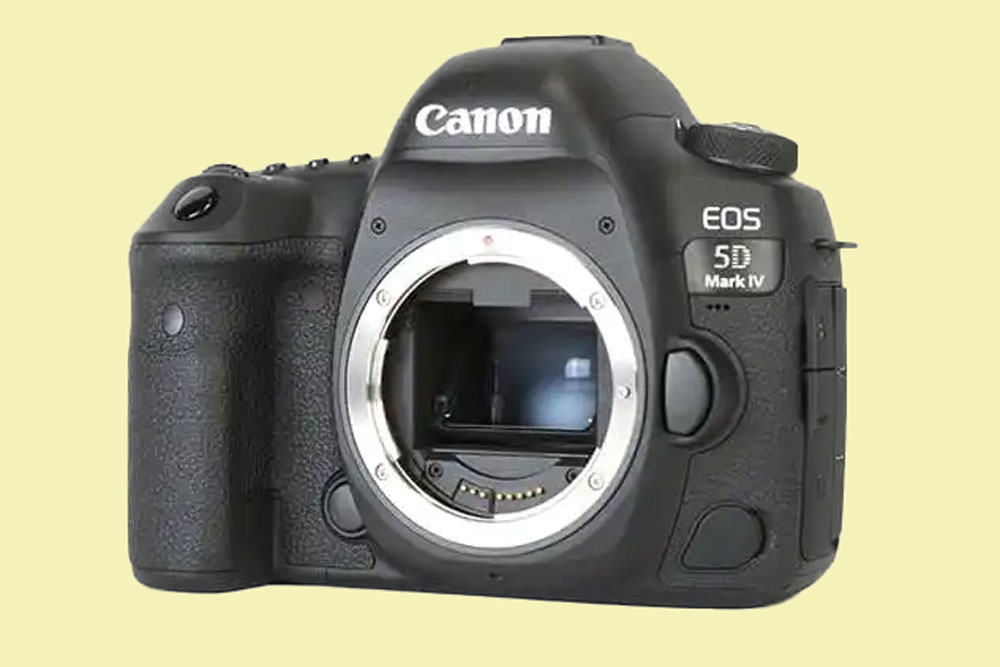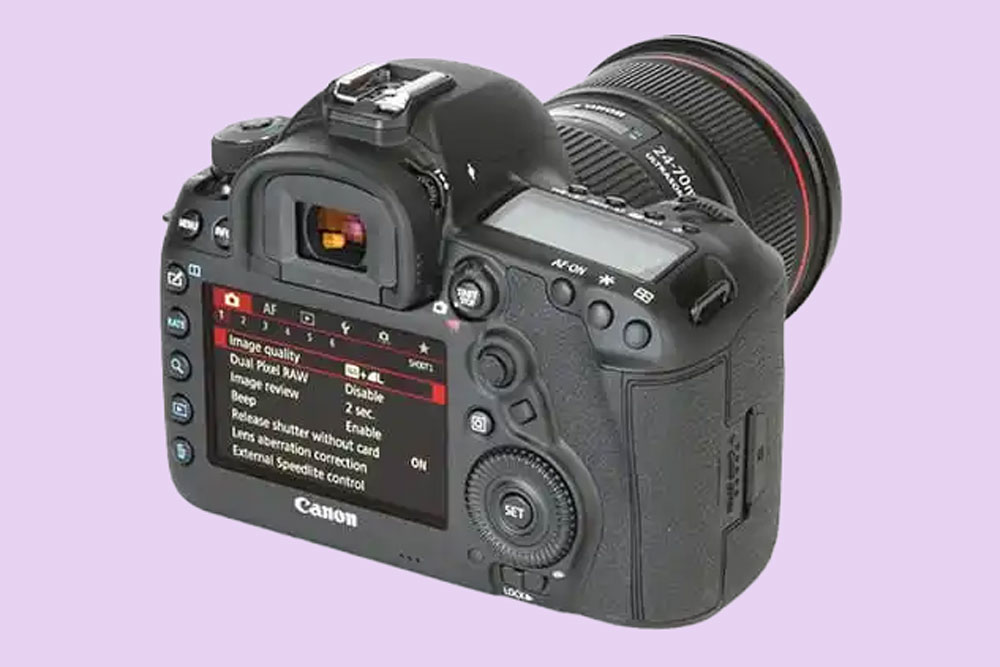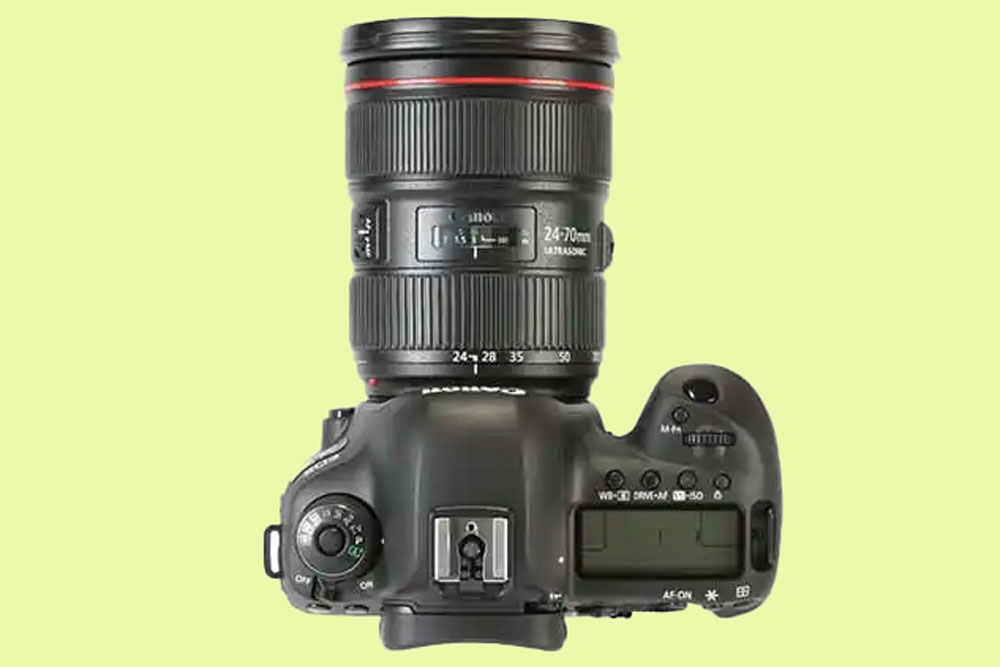The Canon EOS 5D Mark IV has been out for a number of years now, but with Canon concentrating on its EOS R mirrorless cameras, is the EOS 5D Mark IV still a compelling option? Find out in this review, as you may be impressed by how it performs, particularly when you factor in the second-hand prices for this model!
Amateur Photographer verdict
The sensor’s performance at high ISO, combined with radically improved dynamic range make this an improvement on its predecessor.Canon EOS 5D Mark IV: Introduction
Canon’s EOS 5D dynasty stretches back to 2005 and it has proved incredibly popular fuelled by a succession of superb Canon DSLRs. Essentially, the full-frame EOS 5D series was just one step down from the flagship, deep-bodied EOS-1 family and the two ranges shared many features and technologies.
The EOS 5D series had the advantage of a more compact but still rugged body and the emphasis was very much on image quality rather than out and out speed which was more the province of the Canon EOS-1 models.
At a glance:
- $2,299 / £2,027 new body only
- $1,000-1,375/ £1,030-1,200used body only
- 30.4-million-pixel full-frame CMOS sensor
- Dual DIGIC 6 & DIGIC 6+ processors
- ISO 100-32,000 (expandable to ISO 50-102,400)
- 7fps continuous shooting
- 61-point AF system with 41 cross-type
- 3.2in, 1,620k-dot touchscreen
- Built-in Wi-fi, NFC and GPS
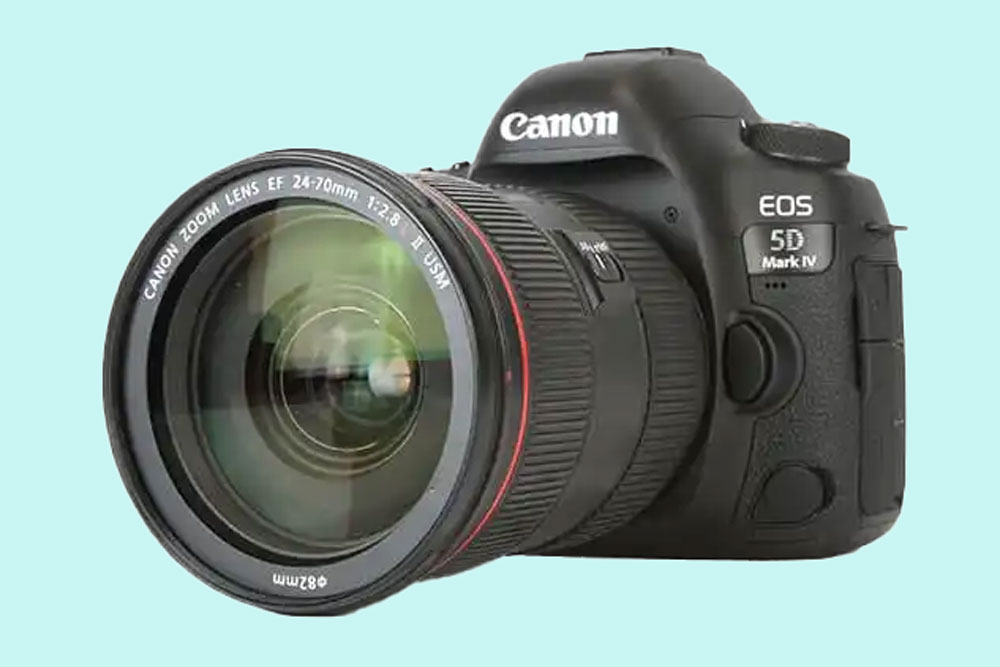
The EOS 5D Mark IV might yet prove to be Canon’s last model in its full-frame DSLR series but what a wonderful picture-making machine it has proved to be for photographers of all genres. The camera is still available new and it has been around long enough for there to be thriving used and second-hand market.
Its tough, nicely proportioned body houses a full-frame CMOS sensor that boasts a resolution of 30.4MP and the camera’s processing power means you can shoot full-size Raws at 7fps. Add a native ISO range of 100 to 32,000 expandable to ISO 50-102,400 and a 61 zone AF system and you have a camera that can satisfy the most demanding user and photo situation.
Canon EOS 5D Mark IV: Features
Since the arrival of the EOS 5D Mark III in 2012, we’ve seen many new developments and technologies roll out across Canon’s line-up of DSLRs. We’re used to seeing a new sensor in each iteration in the 5D-series and this latest model continued that trend. It boasted a 30.4-million-pixel CMOS sensor thatwass quite a jump up from the 22.3MP CMOS sensor fitted inside the EOS 5D Mark III. The improved sensitivity range of ISO 100-32,000 (expandable to ISO 50-102,400) combined with developments to the noise-processing algorithm to enhance its performance in low-light – something we’ll touch on in more detail later in this review.
The EOS 5D Mark IV’s sensor now benefits from Dual Pixel CMOS AF, making it the second full-frame DSLR in Canon’s line-up to feature such technology. This sensor-based phase-detection AF system has been employed to overcome slow focusing speeds in live view and works on the principle of splitting all the effective pixels on the surface of the sensor into two individual photodiodes – one for left and one for right. Each of these photodiodes can be read separately, resulting in faster phase-detection autofocus while simultaneously being used for image capture. In addition, the Dual Pixel CMOS AF system supports Servo AF when shooting stills in live view, opening up the opportunity to pinpoint focus on a subject and track it as it moves through the frame while the shutter button is half depressed.
Canon’s engineers have been hard at work experimenting with other ways to utilise the Dual Pixel CMOS AF system and have come up with an innovation called Dual Pixel Raw. The idea behind this technology is that it creates Dual Pixel raw files that contain a pair of images shot from two slightly different points of view. When these files are processed through Canon’s Digital Photo Professional (DPP) software, users have the opportunity to perform unique image adjustments such as fine-tuning the position of maximum sharpness.
Keeping on the theme of focusing, the EOS 5D Mark IV is equipped with the same AF system as that found inside Canon’s flagship DSLR, the EOS-1D X Mark II. The 61 AF points have been given a wider area in which to operate – an 8 per cent vertical expansion in the central area, and 24 per cent more vertical expansion in the peripheral area – offering greater freedom about where subjects can be placed when composing. When light levels drop users can rely on the camera’s ability to focus down to -3EV using the viewfinder, or -4EV in live-view mode and users of teleconverters will be pleased to hear that all 61 AF points on offer are f/8 compatible. There are also five dual cross-type points in the centre that are sensitive down to f/2.8, and as many as 21 cross-type points that can be selected at f/8 for greater precision.
In the past, all EOS 5D-series models have featured a single processor, but for the first time the sensor teams up with a pair of image processors. A DIGIC 6 processor is allocated to metering and works in harmony with Canon’s 150K RGB+IR metering sensor, while a second DIGIC 6+ processor is in charge of handling the camera’s high-speed image processing. This has allowed the camera to shoot faster than its predecessor, albeit by 1fps, with an improved buffer depth. The Mark IV can rattle out a burst at up to 7fps set to continuous high and can shoot a continuous burst at up to 4.3fps in live view with AF tracking. Silent continuous shooting is also possible at up to 3fps, just like it was on the EOS 5D Mark III.
Canon’s 5D-series has a strong legacy in video and the EOS 5D Mark IV offers cinematic DCI 4K video capture (4096×2160) at 30/25/24fps for the first time. There’s also the option to extract 8.8-million-pixel JPEG images directly from 4K movie footage. Full HD recording is also available up to 60fps, together with 120fps or 100fps recording at 720p. Microphone and headphone inputs are provided, and an HDMI connection provides full audio and uncompressed full HD output to external recorders and video monitors, although the same can’t be said for 4K.
Another first and long-overdue addition to the EOS 5D-series is built-in Wi-Fi connectivity, which has been added alongside built-in GPS for those who wish to geotag their shots with location data. The camera also gets support for the International Press and Telecommunications Council’s system (IPTC), which essentially enables users to assign additional details and information about an image to the EXIF data before it’s submitted to galleries and picture desks. So we’re led to believe it’s a feature that has been requested by professionals who demand faster ways of speeding up workflow.
Canon EOS 5D Mark IV: Dual Pixel Raw
Dual Pixel Raw is unique to the Canon EOS 5D Mark IV and utilises both photodiodes on the camera’s 30.4-million-pixel sensor. During Dual Pixel Raw shooting, a single raw file saves two images into the file. One image consists of image data from both photodiodes, while the other image is designed to record image data from just one set of photodiodes. This means the Dual Pixel Raw files contains a normal image as well as parallax information, which can be measured and subject distance information extrapolated.

When a Dual Pixel Raw file is processed through Canon’s Digital Photo Professional (DPP) software, photographers are given the option to perform one of three types of unique image adjustments – Image micro adjustments, bokeh shift and ghosting reduction.
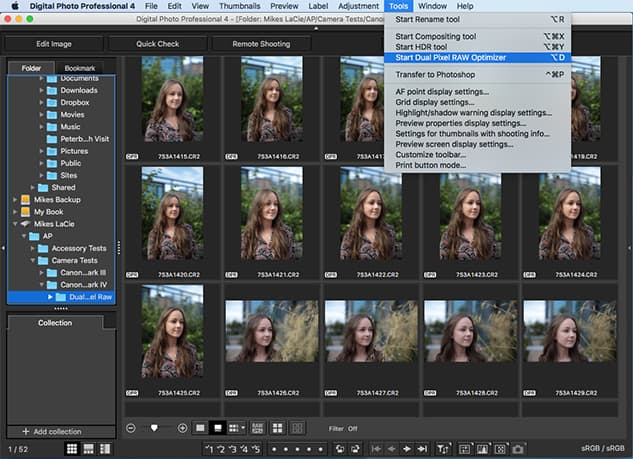
Image micro adjustment allows users to fine-tune the position of maximum sharpness – just imagine you’ve shot a super shallow depth-of-field portrait where the eyes aren’t quite as pin-sharp as you’d hoped before having the option to correct it during post-processing. This is exactly what Dual Pixel Raw has the power to do. The other two adjustments you can make in DPP include bokeh shift, which allows out-of-focus highlights to be shifted horizontally so they coincide better with in-focus elements, and ghosting reduction, which can be used to reduce the appearance of artefacts like flare. But does it work? You can find out how well it works in practice in the performance section of this review.
Canon EOS 5D Mark IV: Build & Handling
Canon has tinkered with the design of its EOS 5D-series since the original and you get the sense the company has now reached a stage where not a great deal more can be done to make its handling any better than it already is. Canon says the handgrip and thumb rest are both designed fractionally deeper, but in truth you’ll be hard pushed to notice a difference on the new model from the EOS 5D Mark III. The same is true of the camera’s weight. The EOS 5D Mark IV sheds 50g off the EOS 5D Mark III by introducing a re-designed mirror box assembly that’s similar to the one used within the EOS 5DS and EOS 5DS R. This assembly uses fewer springs and more cams and gears, with an extra cam added to help eliminate mirror bounce. While we’re all for minimising internal vibrations, the 50g it loses in weight isn’t blatantly obvious when you switch between the Mark IV and Mark III. It should also be noted that the sound of the shutter remains much the same as that of the 5D Mark III.
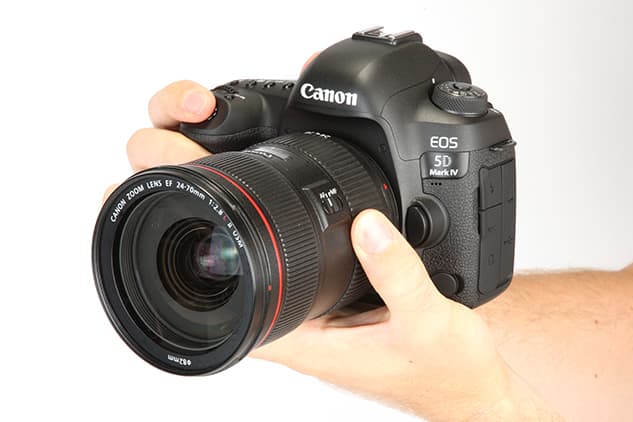
Like that of its peers, the EOS 5D Mark IV’s body is made of magnesium alloy, which gives it a reassuringly solid feel in the hand and the sense that it will survive the demands of enthusiasts and pros. Like with previous generations, Canon has looked at enhancing its robustness with improved weather seals around the body to ensure dirt and moisture do not enter the internals. On the exterior of the body there aren’t too many changes, with buttons and dials falling nicely to hand in the same way they did on the Mark III. The AF joystick now has a knurled texture to it much like the EOS-1D X Mark II and just offset from this there’s a customisable push button that can be located easily when the viewfinder is raised to your eye. It’s assigned to controlling the AF area selection as default, but you’ll still need to hit the AF-point selection button first on the corner of the body before you can use it to toggle through the various AF area settings. Alternatively, this small push button can be appointed to AE lock, AE lock (hold), ISO and exposure compensation. As well as being set up from the main menu, it can be customised from the custom settings that are presented in the Quick menu.

Something we’re yet to comment on that plays a role in the camera’s operation is the 5D Mark IV’s LCD screen. Although it’s similar to the Mark III’s in that it’s the same size (3.2in) and remains fixed as opposed to being the tilting-type, the resolution has increased from 1.04 million dots to 1.62 million dots and now supports touch control. It’s hard not to be impressed at how well the screen reacts to light touches, especially its accuracy, despite some of the menu icons and sub-menus being on the small side.
Existing 5D-series users are most likely to find that they use the camera’s buttons and dials in the traditional way, but there are times, such as when you want to quickly navigate between settings in the quick menu, that the touch screen has its advantages. It can also be used in playback mode to swipe through images – an intuitive way of reviewing images, but it’s not as fast as using the quick control dial.
The same can be said for zooming in to images in playback mode. Due to the screen being that much smaller than a smartphone or tablet, you’ll find you have to repeat finger gestures a few times to inspect images at close magnification before zooming out. This is where a double-tap option to magnify images to inspect sharpness followed by another double tap to zoom out again would be advantageous. On the whole, though, the touch-screen functionality works well and gives users better choice over how the camera is set up.

Other minor body changes involve the remote port being relocated to the front corner of the body from the side. This has freed up room at the side for the 3.5mm mic port to sit directly above the headphone socket and a USB 3.0 port below the HDMI out input. On the opposite side of the body is the same dual-card-slot arrangement that accepts CompactFlash and SD memory cards.

The frustrating news for those looking at the Canon EOS 5D Mark IV as a potential upgrade from the 5D Mark III was that it’s not compatible with the BG-11 battery grip. This slightly short sighted approach from Canon means that those who own a BG-11 grip won’t be able to make the most of it and rules out interchanging grips between cameras. Users of the Mark IV who’d like to duplicate controls when shooting vertically and slot in an additional battery will be forced to buy the Canon BG-E20 ($299 / £399). Other than adding the small push button next to the AF joystick, this grip is virtually identical to the BG-11.
Canon EOS 5D Mark IV: Performance
With the Canon EOS 5D Mark IV having two processors as opposed to one, and one of these exclusively looking after the camera’s image processing, there will be many who hoped for a big improvement in terms of speed. As it stands, the new model is capable of shooting a continuous burst just 1fps than its predecessor. Loaded with a SanDisk Extreme Pro 64GB CompactFlash card, it managed to rattle out 22 raw files before its buffer kicked in. This is four more than we recorded with the same card loaded in an EOS 5D Mark III, but not quite the dramatic improvement or big step up we’d been expecting. Switching the image quality setting from raw to JPEG let the camera off its leash and it managed to rattle out an unlimited number of JPEGs at 7fps, with its predecessor doing the same albeit at 6fps. Enabling Dual Pixel raw sees the frame rate drop from 7fps and after three frames of continuous shooting in this mode the camera slowed signs of slowing down. It’s fairly obvious the speed benefits are fairly modest over the EOS 5D Mark III and will be much more significant for EOS 5D Mark II and original 5D users who feel they’re more restricted by their 3.9fps and 3fps respective burst rates.

As mentioned earlier, there is a silent mode as well as a continuous silent mode that allows users to shoot more discreetly at up to 3fps. Unlike some mirrorless cameras that are capable of shooting completely silently thanks to their electronic shutters, the ‘slap’ in silent mode remains audible. The shutter mechanism is clearly dampened, but naming it a ‘quiet’ or ‘less unobtrusive’ shutter mode instead of ‘silent’, would be far more accurate.
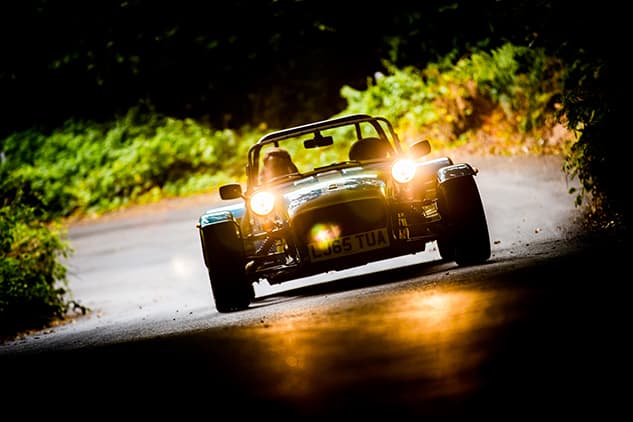
With a 61-point AF system borrowed from Canon EOS-1D X, we expected a pro-level autofocus performance and that’s exactly what you get. Whether it’s used in single or continuous AF, in good light or poor light, it goes about its business of acquiring focus accurately at a rapid pace. The AF case-sensitivity settings it carries over from the Mark III work wonders and the new push button takes the hassle away of having to nip into the menu to change the AF area mode on the fly. Activating live view and experimenting with the AF method to FlexiZone Single AF, and the AF mode to Servo AF revealed the true benefit of Dual Pixel AF. The speed of focusing in live view has come on tenfold since the EOS 5D Mark III and the live tracking also works well provided your subject doesn’t move too erratically or shift outside the boundary that’s displayed on-screen.
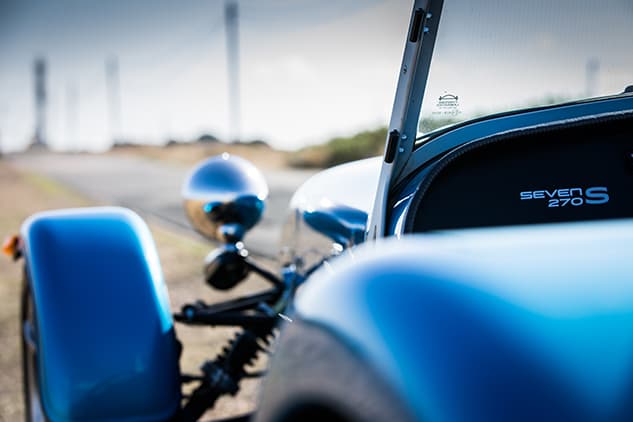
A majority of the images taken during my testing were shot with the camera set to its evaluative-metering mode. I found the metering system performed exceptionally and on the whole did an excellent job of ensuring the highlights weren’t clipped. Only very occasionally did I find myself dialling in -0.3EV in high-contrast scenes. For scenes that might be harder to expose, there’s also spot, partial and centreweighted modes to choose from.
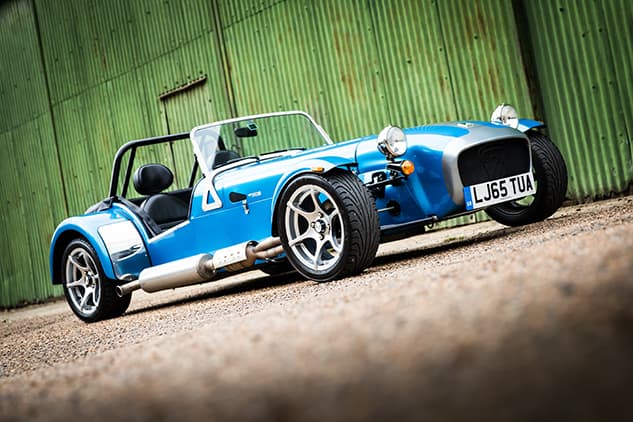
Keen to explore the practical advantages of Dual Pixel raw and the working benefits it brings to pro and enthusiast photographers, I started out by enabling the function from the main menu. You’re given subtle clues to when it’s active, the DPR abbreviation being displayed on the top-plate LCD and also in the viewfinder when it’s selected from the viewfinder display options. After shooting a series of shallow depth-of-field portraits at apertures ranging from f/1.4 to f/2.8, I picked out a few files that weren’t quite as pin-sharp at the point of focus as I would have liked with the hope of improving them.
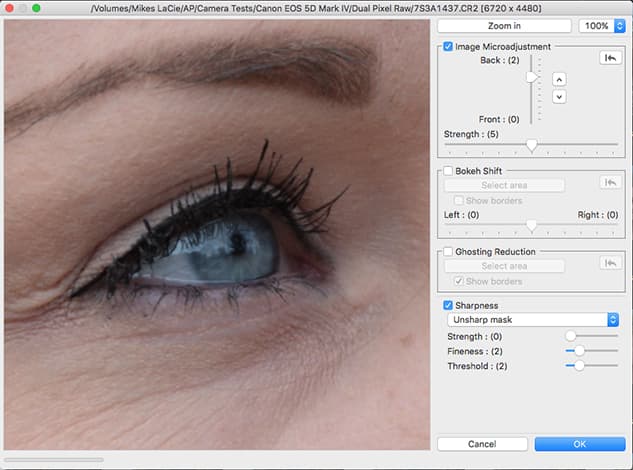
The giveaway of the level of adjustment you have in the Dual Pixel Raw Optimizer that’s located within Canon’s Digital Photo Professional (DPP) software is in the name microadjustment. It’s important not to misinterpret image microadjustment as a way of turning poorly focused images into pin-sharp shots – you’re simply not given this kind of level of control. For shots where you’ve almost nailed the focus, but it’s not razor sharp, it’s possible to adjust the image and bring sharpness back to a desired area. In answer to my earlier question of whether Dual Pixel Raw actually works, the answer is yes it does – just don’t expect large tolerances of control. An attempt at using bokeh shift revealed that this can also be used successfully to adjust the position of out-of-focus areas, or ‘bokeh’ to enhance composition, but just like image microadjustment, the tolerance of top to bottom adjustment is very small.
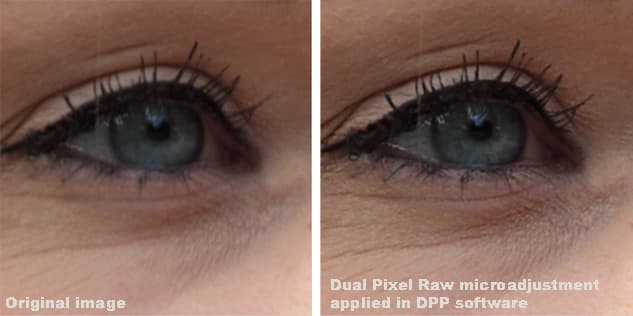
The addition of Wi-Fi connectivity adds another string to the Mark IV’s bow. Having the option to transfer images directly to a smartphone or tablet out in the field can be valuable for photographers who need to share images instantly with clients or those who like to post via the means of social media. To establish the connection between camera and mobile device you’re required to root through the main menu to the communication settings, but having the option to assign the built-in wireless settings to one of the customisable buttons could make this process faster. It goes without saying that using the camera for long periods with Wi-Fi switched on does have a detrimental affect on battery life so you’ll want to use it vigilantly.
Canon EOS 5D Mark IV: Dynamic range, resolution and noise
The question many photographers want to know, particularly those who already own an EOS 5D Mark III, is how well the EOS 5D Mark IV’s 30.4-million-pixel performs and by what margin is it better than the 22.3-million pixel sensor as used in its predecessor. Although it doesn’t quite match the staggering level of detail resolved by the EOS 5DS and 5DS R models, the sensor resolves exceptionally fine detail as our lab results illustrate. The major leap forward in terms of image quality is found in the EOS 5D Mark IV’s improved dynamic range and noise performance, which is aided by the move to on-chip analogue-to-digital conversion. Users are given much greater latitude when it comes to returning detail to shadowed regions, and with the ability of being able to push raw files further, users are given greater confidence to underexpose images in order to preserve highlight detail.
View our Canon EOS 5D Mark IV sample image gallery.
Dynamic range
The EOS 5D Mark IV’s dynamic range offers a notable improvement over its predecessor. Our lab results tell us it offers a 1.6EV improvement in dynamic range over the EOS 5D Mark III at ISO 100. The astonishing 13.7EV readout is the highest dynamic range figure we’ve ever recorded on an EOS DSLR and it manages to stay above 10EV right up to ISO 1,600. Results at ISO 3,200, 6,400 and 12,800 drop to 8.5EV, 7.4EV and 6.5EV respectively, and it’s only when the sensitivity is pushed to ISO 51,200 that we see the dynamic range figure drop below the critical 6EV. This extremely impressive dynamic range performance is welcome news for those who wish to return detail to shadowed regions with minimal noise as a result.
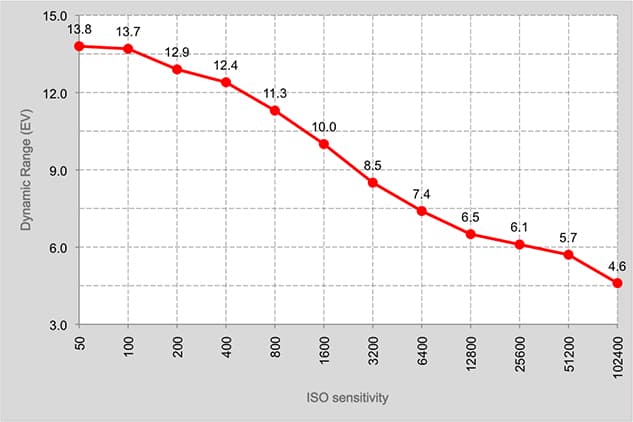
Resolution
Unlike the EOS 5D Mark III, which resolved almost exactly the same level of detail as the EOS 5D Mark II, the EOS 5D Mark IV’s 30.4-million pixel sensor resolves a finer level of detail than its forerunner. A close inspection of our resolution chart shows it resolves a maximum of 3,400l/ph at ISO 100, 3,200l/ph at ISO 400 and 3,000 at ISO 800. Detail remains very high when you reach ISO 1,600 and ISO 3,200, with 2,800l/ph being resolved up to ISO 6,400. As you begin to push the sensitivity higher, fine detail starts to get lost with the introduction of noise, although the sensor shows it’s still more than capable of resolving 2,600l/ph up to its sensitivity ceiling of ISO 32,000 before expansion. Pushing to its H1 (ISO 51,200) and H2 (ISO 102,400) settings sees the level of detail drop to 2,400l/ph and 2,200l/ph respectively.
Below we show details from our resolution chart test pattern (right). Multiply the number beneath the lines by 200 to give the resolution in lines per picture height.
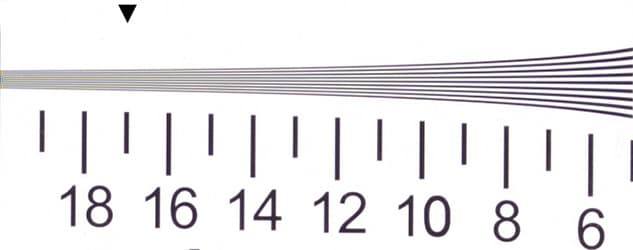
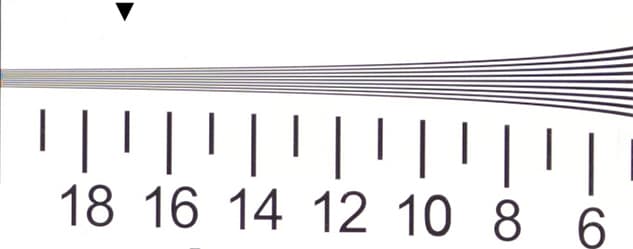
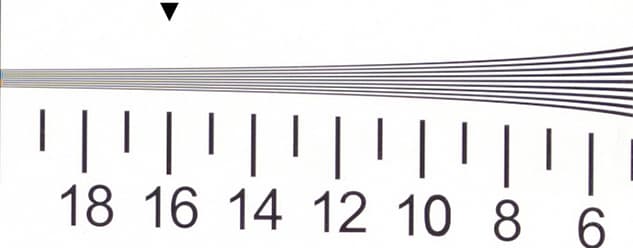
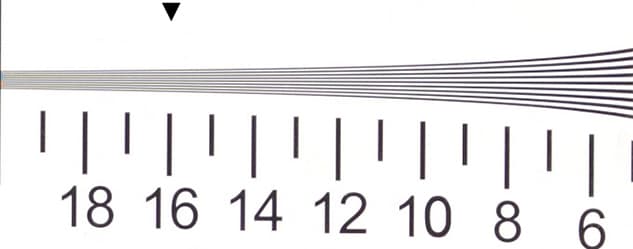
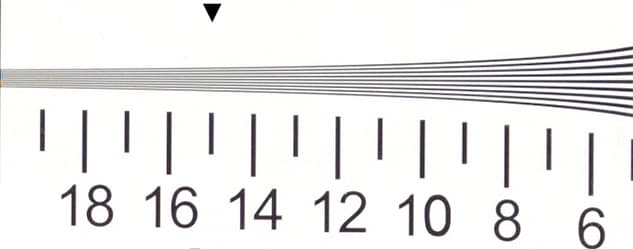
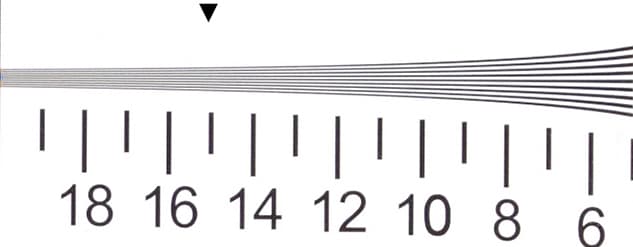
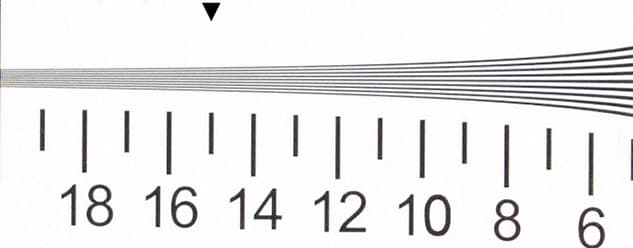
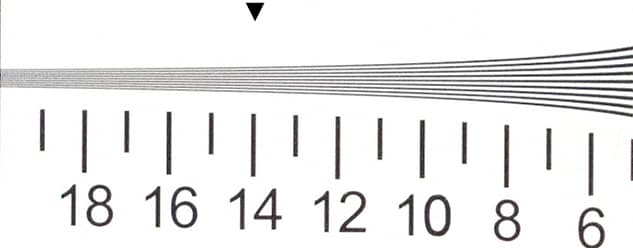
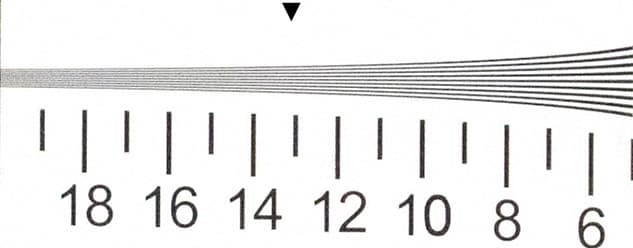
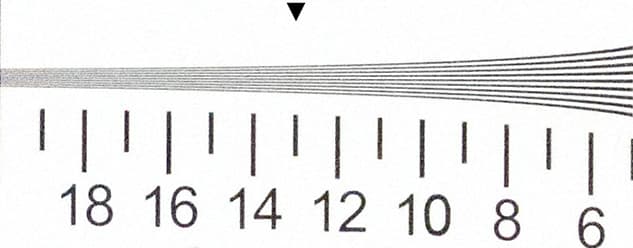
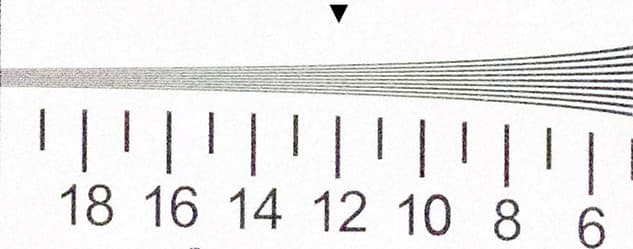
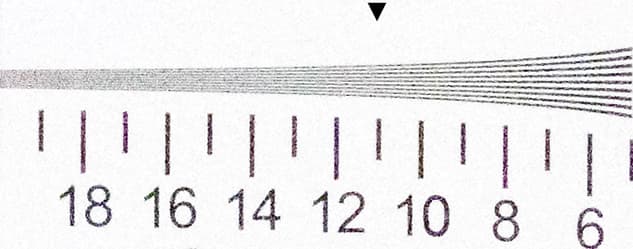
Noise
A higher density of pixels on the same sensor surface area can often translate to more noise at pixel level. However, Canon has worked its magic to ensure that the EOS 5D Mark IV delivers an admirable noise response. An inspection of raw files captured through the sensitivity range displayed clean noise-free results between ISO 100 and 800. Push to ISO 1,600 and you’ll start to see luminance noise appearing, which becomes increasingly evident when you push to ISO 3,200 and ISO 6,400. ISO 3,200 is very usable, and so is ISO 6,400 with some careful application of noise reduction. I’d consider ISO 12,800 to be the upper limit of where I’d want to push the sensitivity on a regular basis, whereas previously on the EOS 5D Mark III I was hesitant to push much beyond ISO 6,400. Detail and colour saturation hold up impressively at ISO 25,600, but the dominance of noise at this setting restricts it to emergency use. The extended ISO 51,200 and ISO 102,400 both see a drop in saturation and should be avoided.
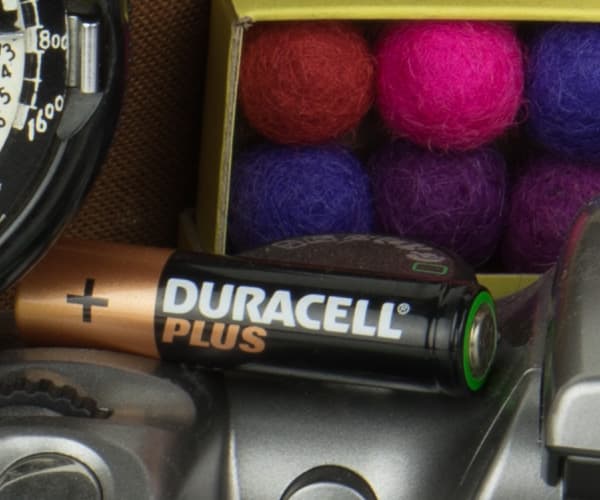
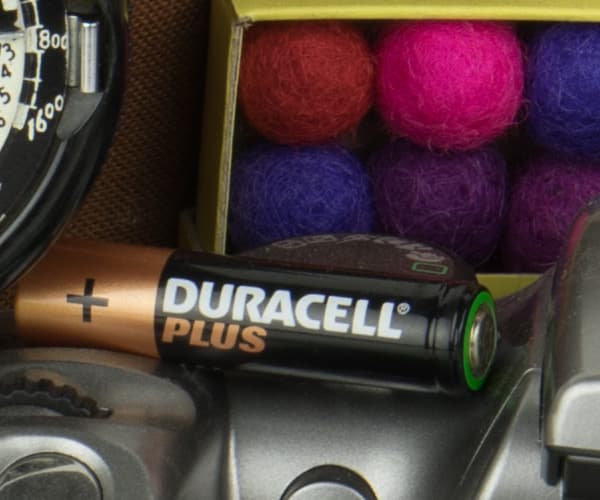
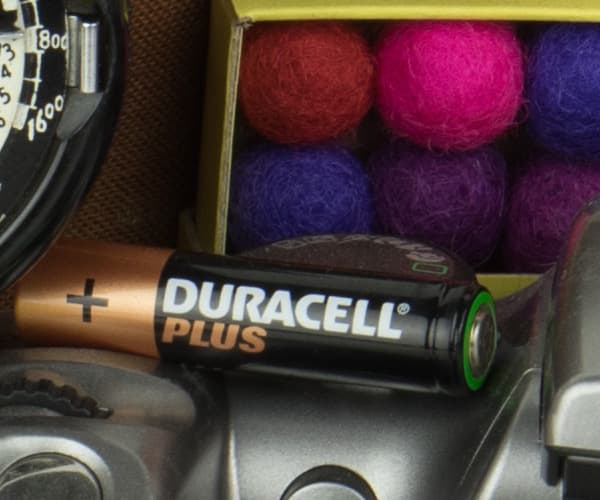
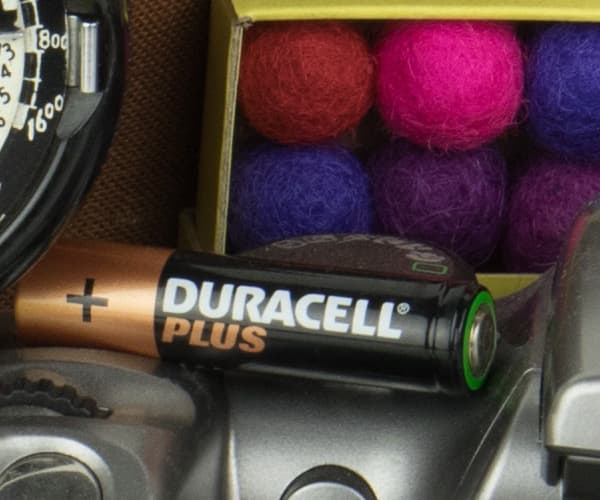
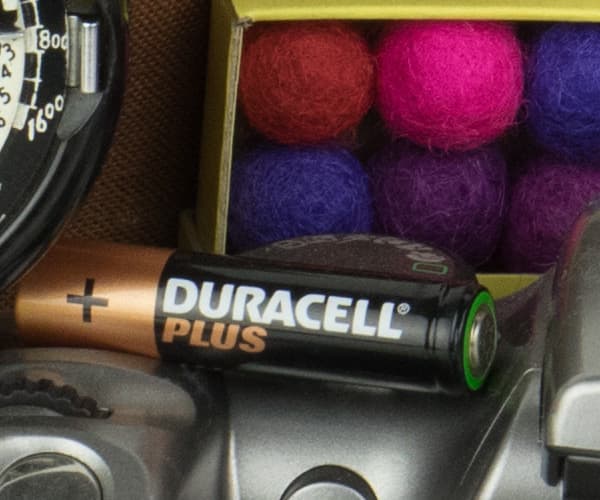
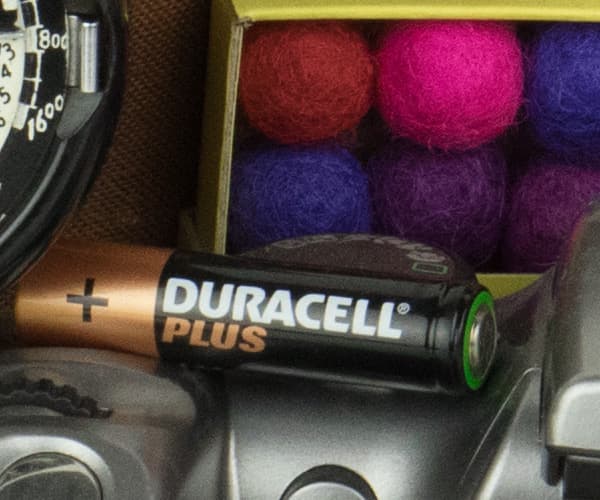
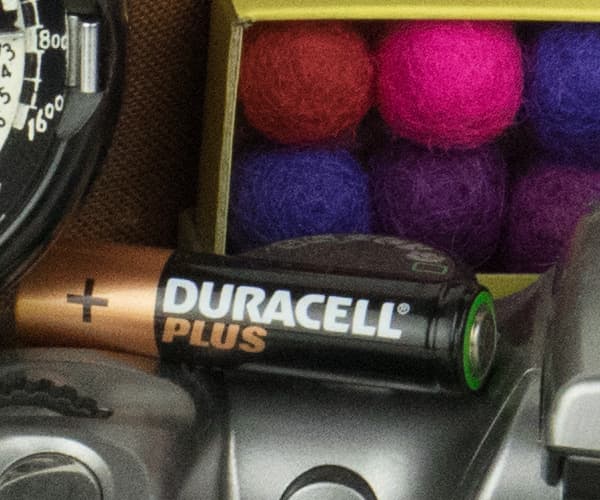
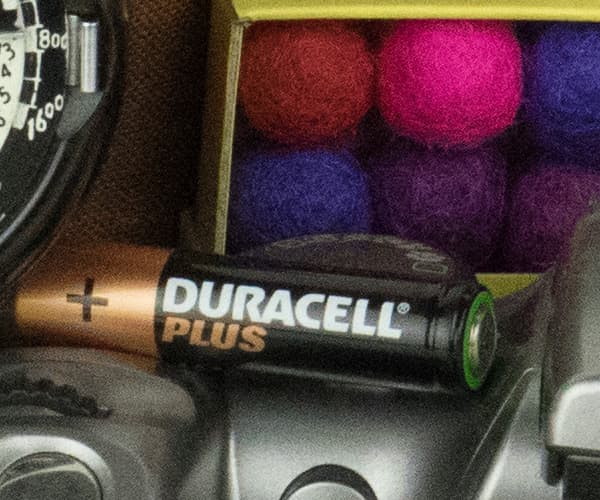
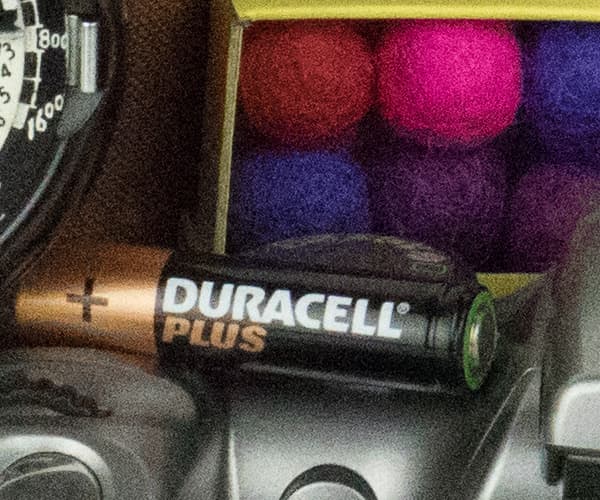
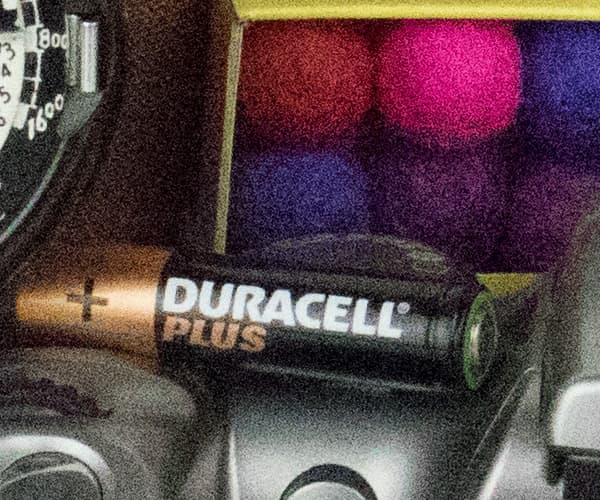
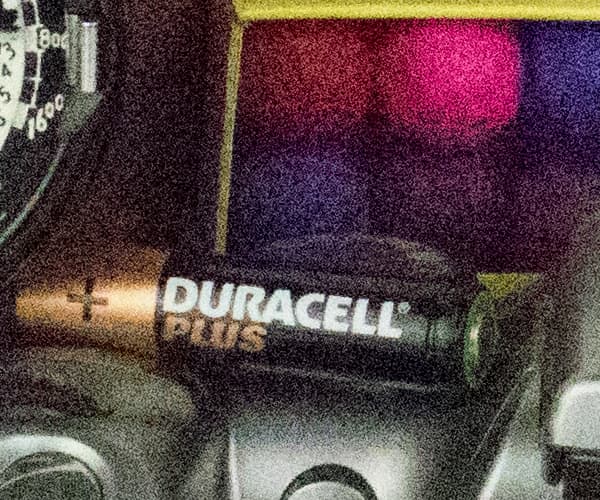
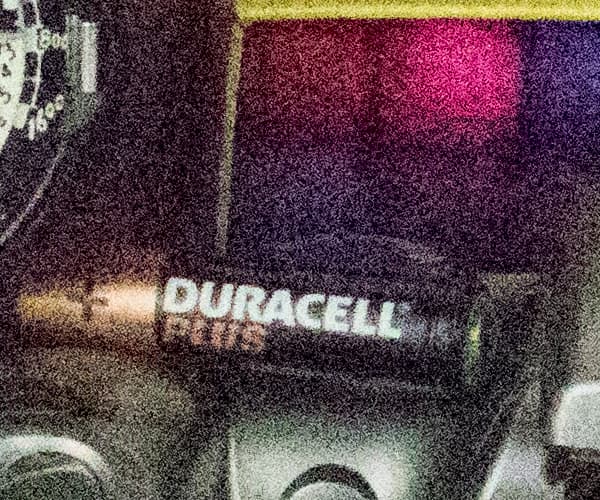
How to connect your Canon to your phone
Canon Camera Connect, is the app that you need, in order to connect your Canon camera to your smartphone or tablet. It lets you view and transfer images on your camera, use remote live view shooting, as well as use location information from your smartphone to Geotag your images. There’s also an option to set up auto-transfer or use the smartphone as a Bluetooth remote control. Using Bluetooth rather than Wi-Fi and live view will help save precious battery life. What’s more, you can also update the firmware, but this function is only available for newer releases like the Canon EOS R5, Canon EOS R6 and R3 models, and products announced after 2022.
For more functions and detailed steps read our guide to Using the Canon Camera Connect app.
Canon EOS 5D Mark IV: Verdict
The Canon EOS 5D Mark IV did bring along some enticing features to its DSLR line-up, but arguably it was the 30.4-million-pixel sensor that stole the limelight. The sensor’s performance at high ISO, combined with its radically improved dynamic range, made it markedly better than the EOS 5D Mark III when it came to returning high levels of detail to shadowed areas in post-production and shooting images with less digital noise in low-light. The addition of DCI 4K video is likely to allure filmmakers as well as those purely focused on stills photography, but its 1.74x crop factor and lack of a clean 4K HDMI output and log shooting options are factors that could put videographers off.

For the enthusiast and pro photographer looking for a great performing DSLR all-rounder, the EOS 5D Mark IV ticks a lot of the right boxes. It handles well, is built to a robust standard, and it adds long overdue features such as Wi-Fi, GPS and touchscreen control. Canon will argue that a fixed screen helps to improve its weather sealing, but tilting displays are now common and have many plus points, and it did feel something of an inconvenience having to lie on the floor to compose low-level shots.

Improvements to the 61-point AF system will benefit those who regularly shoot with teleconverters and the spritely autofocus performance in live view matches the speed of other DSLRs in Canon’s EOS line-up. As for Dual Pixel Raw, it’s an innovation that has its uses, particularly when you’re shooting images with an extremely shallow depth of field, but from my personal experience it slowed down my workflow a little too much and as a result would only be used sparingly.
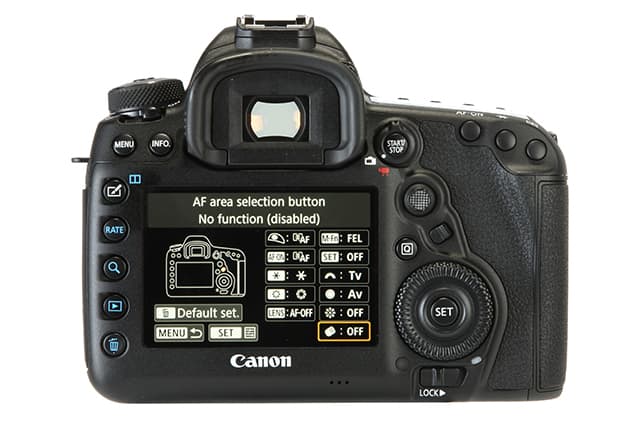
The EOS 5D Mark IV is the most advanced EOS-5D-series model we’ve seen to date, but now priced at $2,699 or £2,790 body only it will leave a big dent in your wallet if you buy it new. Those who own an EOS 5D Mark III and are content with the image quality produced by their 22.3-million-pixel CMOS sensor will find it hard justifying an upgrade. Original EOS 5D and EOS 5D Mark II users who skipped the Mark III are more likely to justify an upgrade. As all-round full-frame DSLRs go, the Canon EOS 5D Mark IV remains an excellent DSLR and great value at its price. It’s even better value if you take the pre-owned route where you can expect to pay $1,039-1,320 / £1,039-1,259 depending on condition and the number of shutter actuations.
Follow AP on Facebook, Twitter, Instagram, YouTube and TikTok.


